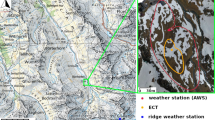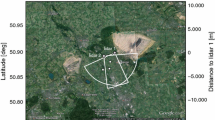Abstract
The thermal structure of an air-water interface is investigated by examining thermal imagery obtained from a high resolution infrared (IR) sensor. The experiments were performed at the ASIST facility at the University of Miami for wind speeds ranging from approximately 2 ms−1 to 10 ms−1 and for flux based Richardson numbers ranging from about 10−2 to 10−5. Two cases were examined: (1) the so-called cool-skin case where the water surface was significantly cooler than the bulk water temperature and (2) the warm-skin case where the water surface was warmer than the bulk. In the cool-skin case, the low wind speed results reveal a cellular structure reminiscent of earlier results in which the lateral length scale of the cells (or fish-scales) varies as the inverse of the friction velocity. The imagery clearly reveals the progression from non-breaking gravity waves, to a system of omnidirectional breaking which seems to create a nearly isotropic surface temperature field. Though no wind waves were present at low wind speeds, the thermal imagery reveals the existence of persistent, highly coherent, Langmuir-like cell structures which were marked by surface convergent zones in which ambient surfactant may have accumulated. Imagery obtained for the case in which the water-side thermal boundary layer is stable constitutes a novel aspect of this work. In this warm-skin case, the cellular (fish-scale) structure appears as it does in the unstable case, strongly suggesting that these small scale features are due to shear instabilities in the surface layer. In addition, they are more clearly revealed as the natural convective instability of the thermal boundary layer is suppressed. This appears to reduce the appearance of the smallest scales of surface turbulence.
Access this chapter
Tax calculation will be finalised at checkout
Purchases are for personal use only
Preview
Unable to display preview. Download preview PDF.
Similar content being viewed by others
References
A. D. D. Craik and S. Leibovich. Rational model for langmuir circulations. Journal of Fluid Mechanics, 73:401–426, 1976.
T. D. Foster. Intermittent convection. Geophysical Fluid Dynamics, 2: 201–217, 1971.
C. S. Garbe, H. Spies, and B. Jähne. Estimation of surface flow and net heat flux from infrared images sequences. Journal of Mathematical Imaging and Vision, 19:159–174, 2003.
C. S. Garbe, U. Schimpf, and B. Jähne. A surface renewal model to analyze infrared image sequences of the ocean surface for the study of air-sea heat and gas exchange. Journal of Geophysical Research, 109(C08S15), 2004. doi:10.1029/2003JC001802.
R. A. Handler, G. B. Smith, and R. I. Leighton. The thermal structure of an air-water interface at low wind speeds. Tellus Series a-Dynamic Meteorology and Oceanography, 53(2):233–244, 2001.
R. A. Handler, R. I. Leighton, G. B. Smith, and R. Nagaosa. Surfactant effects on passive scalar transport in a fully developed turbulent flow. International Journal of Heat and Mass Transfer, 46(12):2219–2238, 2003.
B. Jähne, P. Libner, R. Fischer, T. Billen, and E. J. Plate. Investigating the transfer processes across the free aqueous viscous boundary layer by the controlled flux method. Tellus, 41B:177–195, 1989.
A. T. Jessup and C. J. Zappa. Defining and quantifying microscale wave breaking with infrared imagery. Journal of Geophysical Research, 102(C10):23,145–23,153, 1997.
A. T. Jessup, C. J. Zappa, M. R. Loewen, and V. Hesany. Infrared remote sensing of breaking waves. Nature, 385(6611):52–55, 1997.
K. P. Judd, S. Phongikaroon, G. B. Smith, and R. A. Handler. Thermal structure of clean and contaminated free-surfaces subject to an impinging gas jet. Experiments in Fluids, 38(1):99–111, 2005.
K. B. Katsaros, W. T. Liu, J. A. Businger, and J. E. Tillman. Heattransport and thermal structure in interfacial boundary-layer measured in an open tank of water in turbulent free convection. Journal of Fluid Mechanics, 83:311–335, 1977.
S. J. Kline, W. C. Reynolds, J. A. Schraub, and P. W. Runstadler. The structure of turbulent boundary layers. Journal of Fluid Mechanics, 30:741–773, 1967.
R. I. Leighton, G. B. Smith, and R. A. Handler. Direct numerical simulations of free convection beneath an air-water interface at low rayleigh numbers. Physics of Fluids, 15(10):3181–3193, 2003.
G. O. Marmorino and G. B. Smith. Bright and dark ocean whitecaps observed in the infrared. Geophysical Research Letters, 32(11):L11604, 2005.
G. O. Marmorino, G. B. Smith, and G. J. Lindemann. Infrared imagery of ocean internal waves. Geophysical Research Letters, 31(11):L11309, 2004.
G. O. Marmorino, G. B. Smith, and G. J. Lindemann. Infrared imagery of large-aspect-ratio langmuir circulation. Continental Shelf Research, 25(1):1–6, 2005.
E. D. McAlister and W. McLeish. Heat transfer in the top millimeter of the ocean. Journal of Geophysical Research, 74:3408–3414, 1969.
P. J. Minnett, R. O. Knuteson, F. A. Best, B. J. Osborne, J. A. Hanafin, and O. B. Brown. The marine-atmospheric emitted radiance interferometer: A high-accuracy, seagoing infrared spectroradiometer. Journal of Atmospheric and Ocean Technology, 18(6):994–1013, 2001.
J. R. Saylor, G. B. Smith, and K. A. Flack. The effect of a surfactant monolayer on the temperature field of a water surface undergoing evaporation. International Journal of Heat and Mass Transfer, 43(17):3073–3086, 2000.
U. Schimpf, C. S. Garbe, and B. Jähne. Investigation of transport processes across the sea surface microlayer by infrared imagery. Journal of Geophysical Research, 109(C08S13), 2004. doi:10.1029/2003JC001803.
C. R. Smith and S. P. Metzler. The characteristics of low-speed streaks in the near-wall region of the turbulent boundary layer. Journal of Fluid Mechanics, 129:27–54, 1983.
G. B. Smith, R. J. Volino, R. A. Handler, and R. I. Leighton. The thermal signature of a vortex pair impacting a free surface. Journal of Fluid Mechanics, 444:49–78, 2001.
A. V. Soloviev and P. Schlüssel. Parameterization of the skin of the ocean and of the air-ocean gas transfer on the basis of modeling surface renewal. Journal of Physical Oceanography, 24:1339–1346, 1994.
F. Veron and W. K. Melville. Experiments on the stability and transition of wind-driven water surfaces. Journal of Fluid Mechanics, 446: 25–65, 2001.
B. Ward and M. Donelan. Thermometric measuremnets of the molecular sublayer at the air-water interface. Geophysical Research Letters, 33(L07605), 2006. doi:10.1029/2005GL024769.
C. J. Zappa, A. T. Jessup, and H. Yeh. Skin layer recovery of freesurface wakes: Relationship to surface renewal and dependence on heat flux and background turbulence. Journal of Geophysical Research, 103(C10):21,711–21,722, 1998.
C. J. Zappa, W. E. Asher, A. T. Jessup, J. Klinke, and S. R. Long. Microbreaking and the enhancement of air-water transfer velocity. Journal of Geophysical Research, 109(C08S16), 2004. doi:10.1029/2003JC001897.
Author information
Authors and Affiliations
Editor information
Editors and Affiliations
Rights and permissions
Copyright information
© 2007 Springer-Verlag Berlin, Heidelberg
About this chapter
Cite this chapter
Smith, G.B., Handler, R.A., Scott, N. (2007). Observations of the Structure of the Surface Temperature Field at an Air-Water Interface for Stable and Unstable Cases. In: Garbe, C.S., Handler, R.A., Jähne, B. (eds) Transport at the Air-Sea Interface. Environmental Science and Engineering. Springer, Berlin, Heidelberg. https://doi.org/10.1007/978-3-540-36906-6_15
Download citation
DOI: https://doi.org/10.1007/978-3-540-36906-6_15
Publisher Name: Springer, Berlin, Heidelberg
Print ISBN: 978-3-540-36904-2
Online ISBN: 978-3-540-36906-6
eBook Packages: Earth and Environmental ScienceEarth and Environmental Science (R0)




